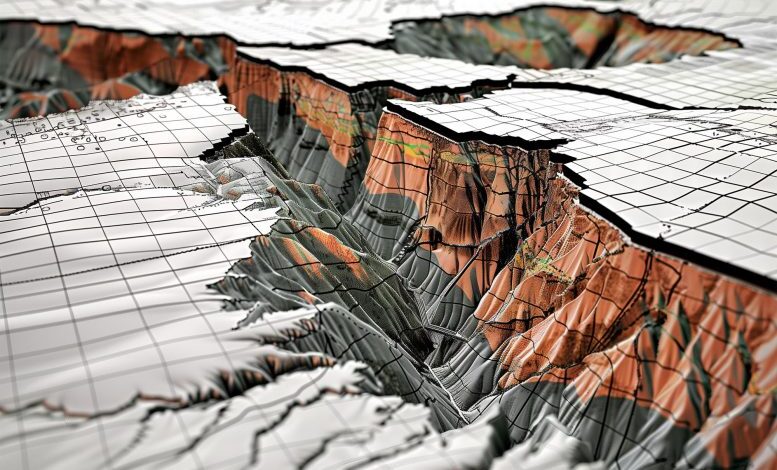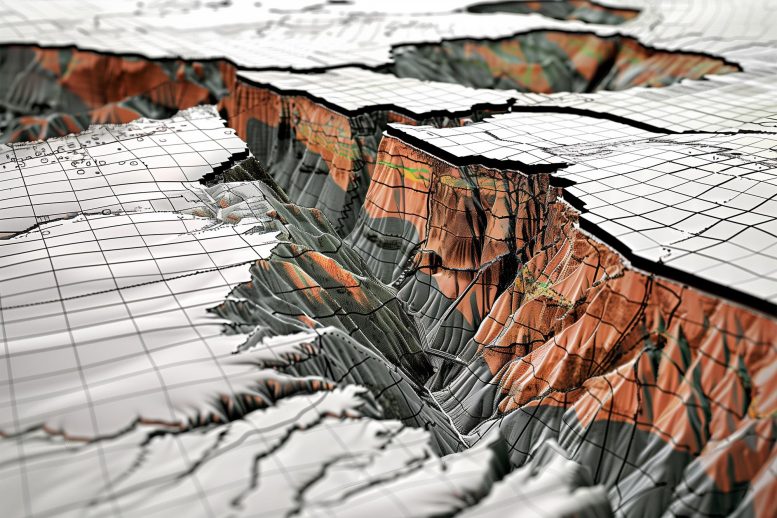Geometry as the Groundbreaking Predictor of Earthquakes


Researchers at Brown University have discovered that the geometry of fault networks, rather than just the friction at fault lines, significantly influences earthquake occurrence and intensity. Credit: SciTechDaily.com
Brown University researchers found that fault geometry, including misalignments and complex structures within fault zones, plays a crucial role in determining earthquake likelihood and strength. This finding, based on studies of California’s fault lines, challenges traditional views that focus primarily on friction.
By taking a close look at the geometrical makeup of rocks where earthquakes originate, researchers at Brown University are adding a new wrinkle to a long-held belief about what causes seismic quakes in the first place.
Rethinking Earthquake Dynamics
The research, described in a newly published article in the journal Nature, reveals that the way fault networks are aligned plays a critical role in determining where an earthquake will happen and its strength. The findings challenge the more traditional notion that it is primarily the type of friction happening at these faults that governs whether earthquakes happen or not, and they could improve current understandings of how earthquakes work.
“Our paper paints this very different sort of picture about why earthquakes happen,” said Brown geophysicist Victor Tsai, one of the paper’s lead authors. “And this has very important implications for where to expect earthquakes versus where to not expect earthquakes, as well as for predicting where the most damaging earthquakes will be.”
Traditional Views on Earthquake Mechanics
Fault lines are the visible boundaries on the planet’s surface where the rigid plates that make up the Earth’s lithosphere brush against each another. Tsai says that for decades, geophysicists have explained earthquakes as happening when stress at faults builds up to the point where the faults rapidly slip or break past each other, releasing pent-up pressure in an action known as stick-slip behavior.
Researchers theorized that the rapid slip and intense ground motions that follow are a result of unstable friction that can happen at the faults. In contrast, the thought is that when friction is stable, the plates then slide against each other slowly without an earthquake. This steady and smooth movement is also known as creep.
New Perspectives on Fault Line Behavior
“People have been trying to measure these frictional properties, like whether the fault zone has unstable friction or stable friction and then, based on laboratory measurements of that, they try to predict if are you going to have an earthquake there or not,” Tsai said. “Our findings suggest that it might be more relevant to look at the geometry of the faults in these fault networks, because it may be the complex geometry of the structures around those boundaries that creates this unstable versus stable behavior.”
The geometry to consider includes complexities in the underlying rock structures such as bends, gaps and stepovers. The study is based on mathematical modeling and studying fault zones in California using data from the U.S. Geological Survey’s Quaternary Fault Database and from the California Geological Survey.
Detailed Examples and Previous Research
The research team, which also includes Brown graduate student Jaeseok Lee and Brown geophysicist Greg Hirth, offer a more detailed example to illustrate how earthquakes happen. They say to picture the faults that brush up against each other as having serrated teeth like the edge of a saw.
When there are fewer teeth or teeth that are not as sharp, the rocks slide past each other more smoothly, allowing for creep. But when the rock structures in these faults are more complex and jagged, these structures catch on to one another and get stuck. When that happens, they build up pressure and eventually as they pull and push harder and harder, they break, jerking away from each other and leading to earthquakes.
Implications of Geometrical Complexity
The new study builds on previous work looking at why some earthquakes generate more ground motion compared to other earthquakes in different parts of the world, sometimes even those of similar magnitude. The study showed that blocks colliding inside a fault zone as an earthquake happens contributes significantly to the generation of high-frequency vibrations and sparked the notion that maybe geometrical complexity beneath the surface was also playing a role in where and why earthquakes happen.
Misalignment and Earthquake Intensity
Analyzing data from faults in California — which include the well-known San Andreas fault — the researchers found that fault zones that have complex geometry underneath, meaning the structures there weren’t as aligned, turned out to have stronger ground motions than less geometrically complex fault zones. This also means some of these zones would have stronger earthquakes, others would have weaker ones, and some would have no earthquakes.
The researchers determined this based on the average misalignment of the faults they analyzed. This misalignment ratio measures how closely the faults in a certain region are aligned and all going in the same direction versus going in many different directions. The analysis revealed that fault zones where the faults are more misaligned causes stick-slip episodes in the form of earthquakes. Fault zones where the geometry of the faults were more aligned facilitated smooth fault creep with no earthquakes.
“Understanding how faults behave as a system is essential to grasp why and how earthquakes happen,” said Lee, the graduate student who led the work. “Our research indicates that the complexity of fault network geometry is the key factor and establishes meaningful connections between sets of independent observations and integrates them into a novel framework.”
Future Directions in Earthquake Research
The researchers say more work needs to be done to fully validate the model, but this initial work suggests the idea is promising, especially because the alignment or misalignment of faults is easier to measure than fault frictional properties. If valid, the work can one day be weaved into earthquake prediction models.
That remains far off for now as the researchers begin to outline how to build upon the study.
“The most obvious thing that comes next is trying to go beyond California and see how this model holds up,” Tsai said. “This is potentially a new way of understanding how earthquakes happen.”
Reference: “Fault-network geometry influences earthquake frictional behaviour” by Jaeseok Lee, Victor C. Tsai, Greg Hirth, Avigyan Chatterjee and Daniel T. Trugman, 5 June 2024, Nature.
DOI: 10.1038/s41586-024-07518-6
The research was supported by the National Science Foundation. Along with Lee, Tsai and Hirth, the team also included Avigyan Chatterjee and Daniel T. Trugman from the University of Nevada Reno.

